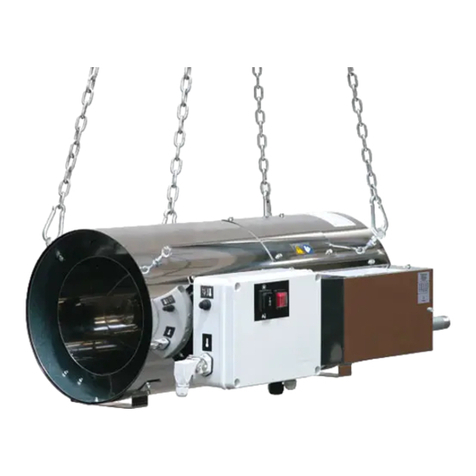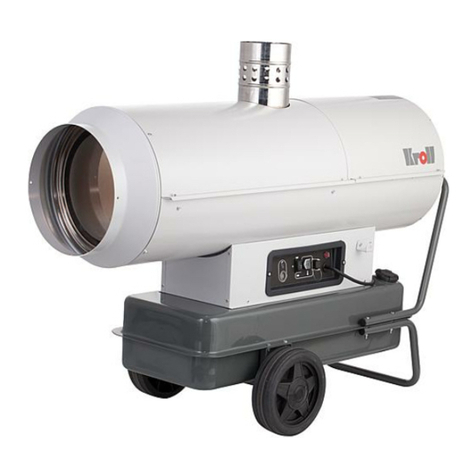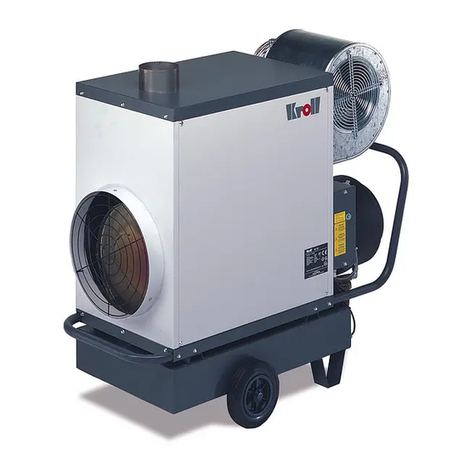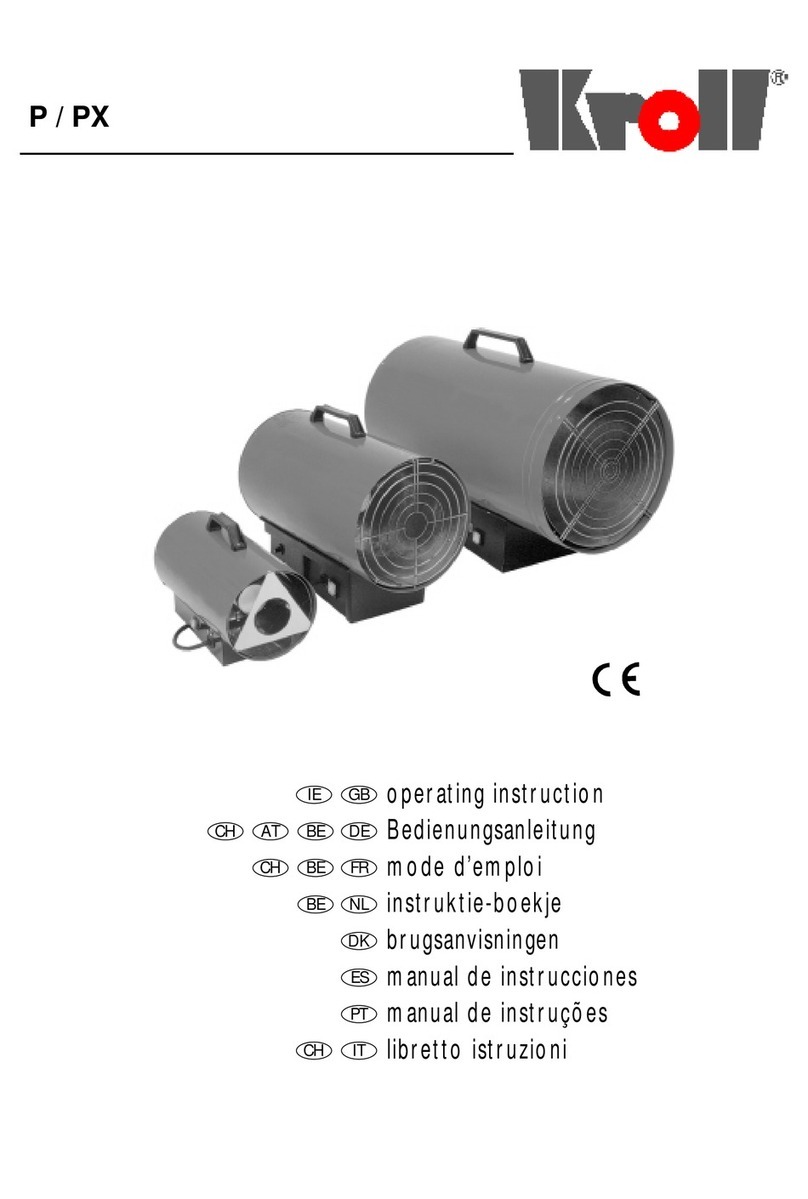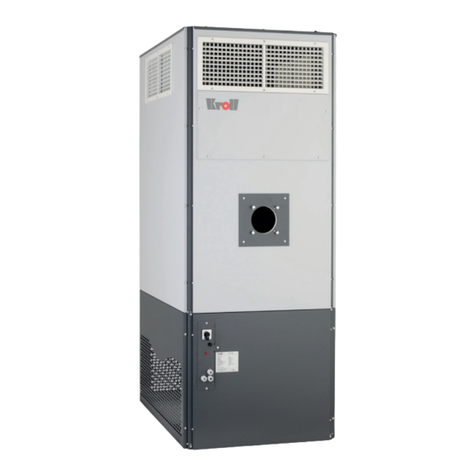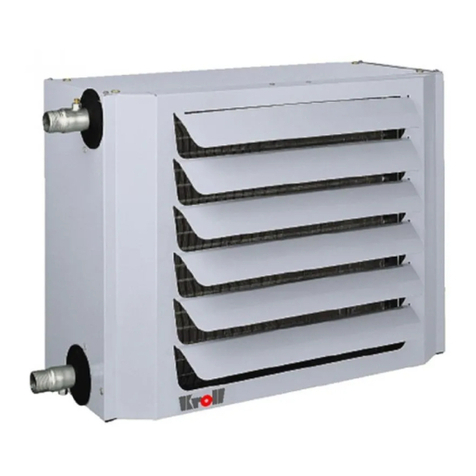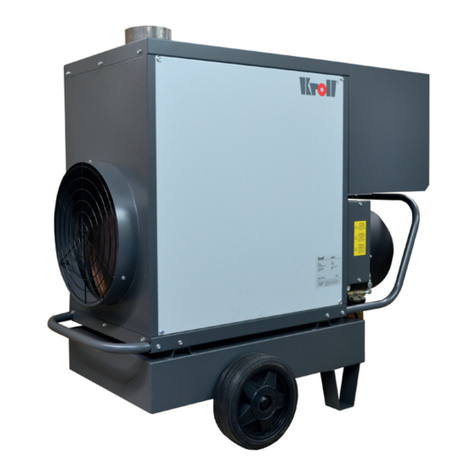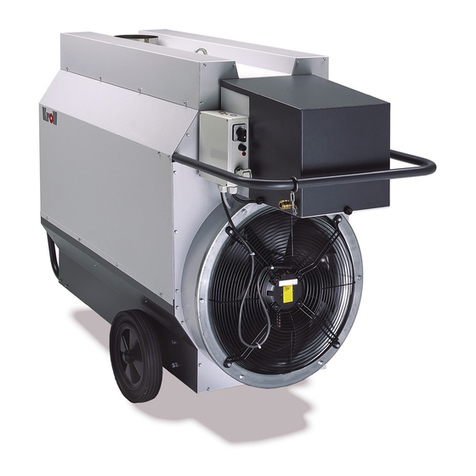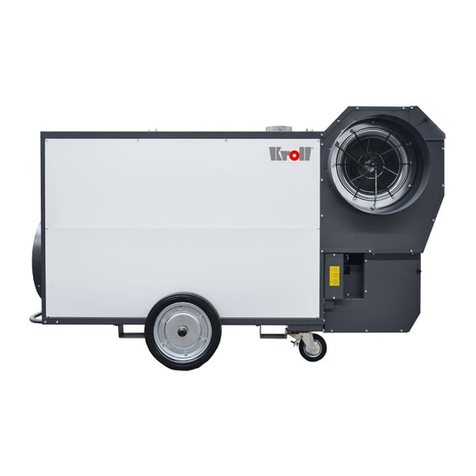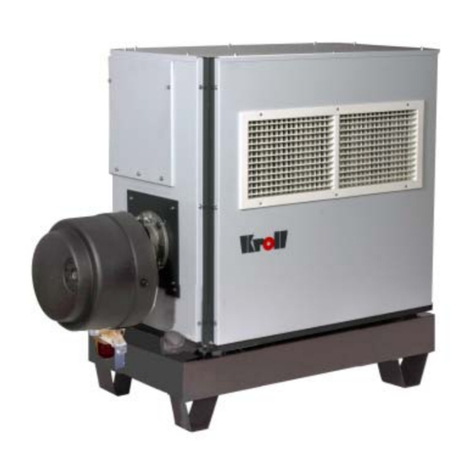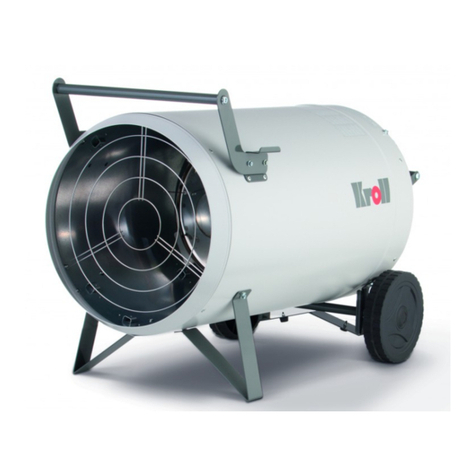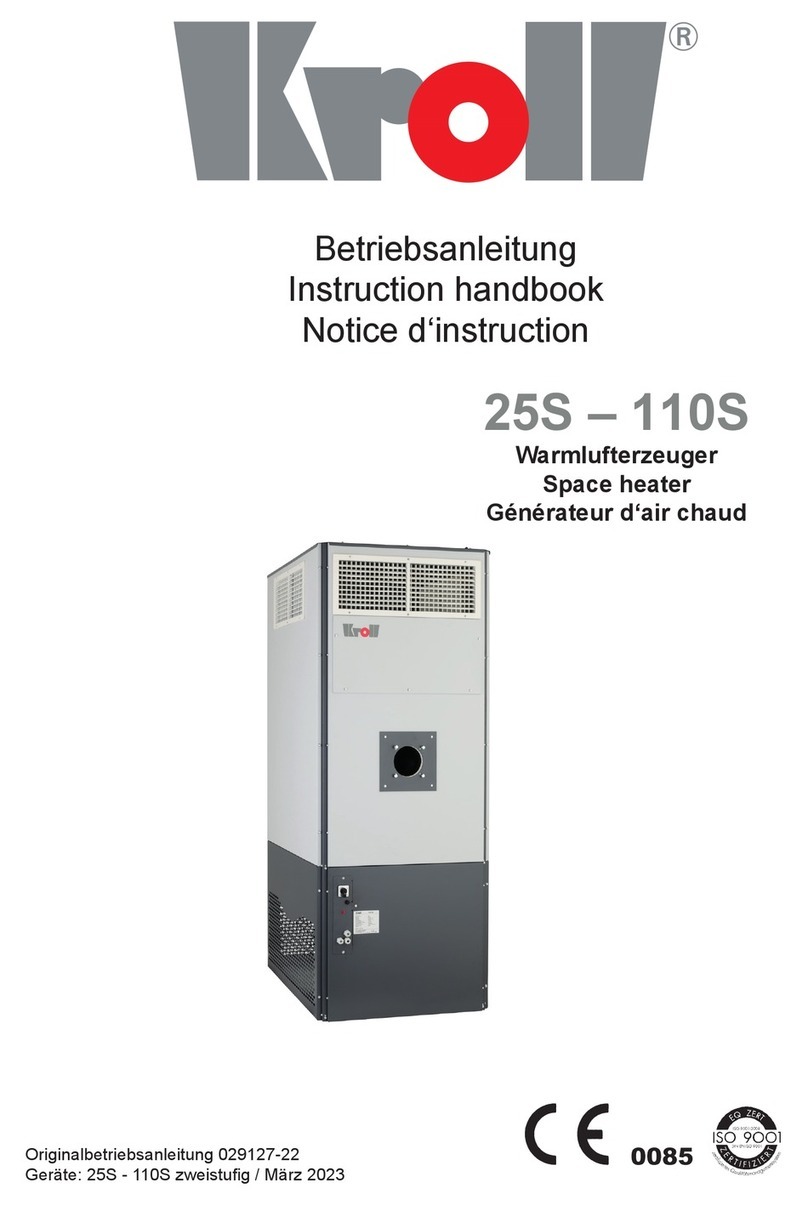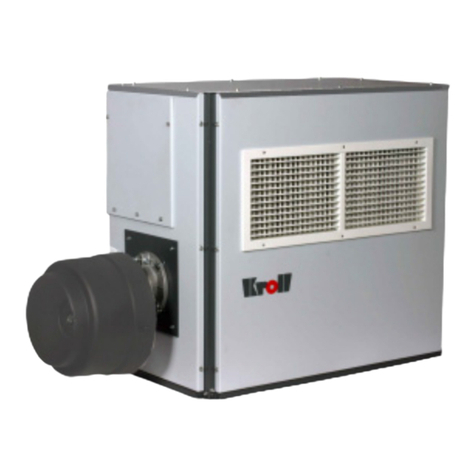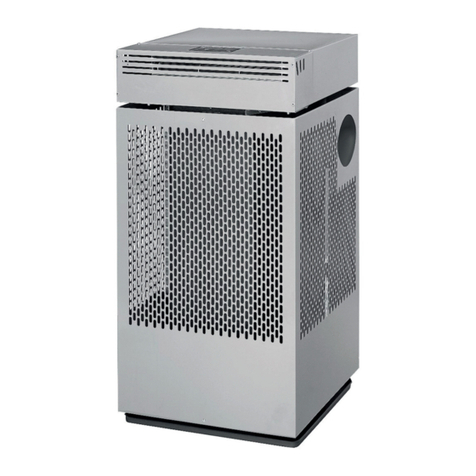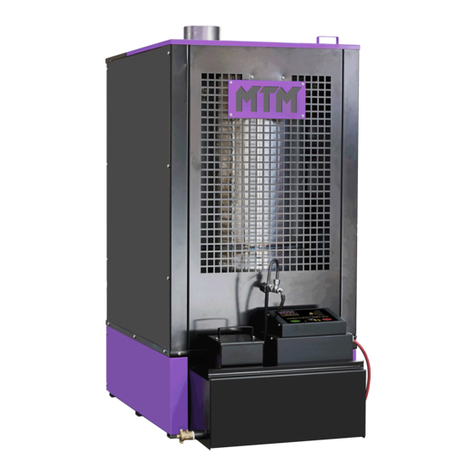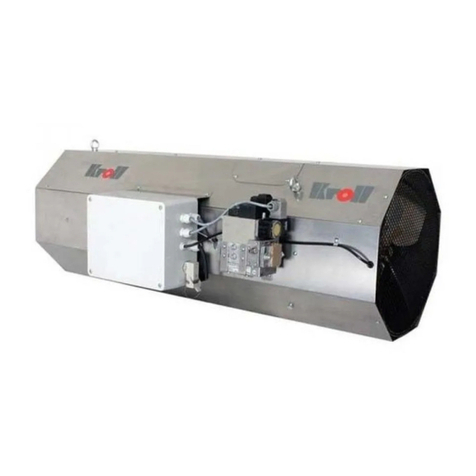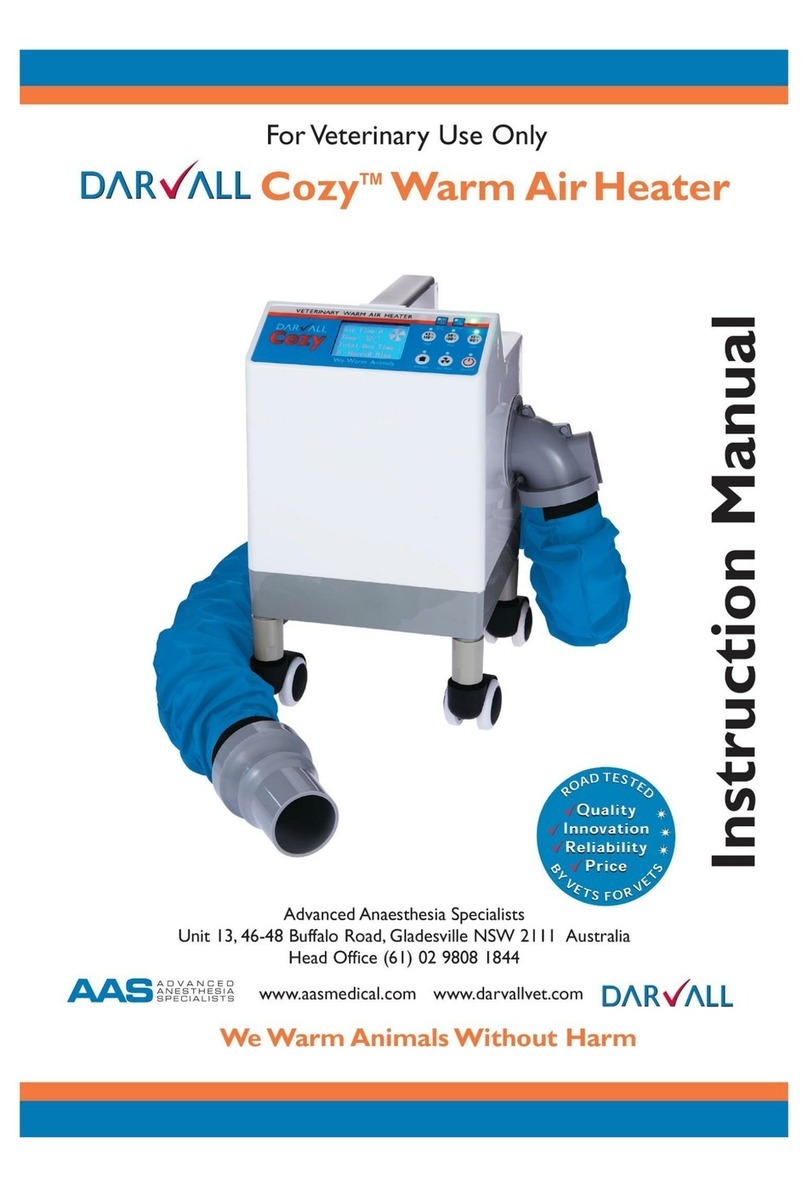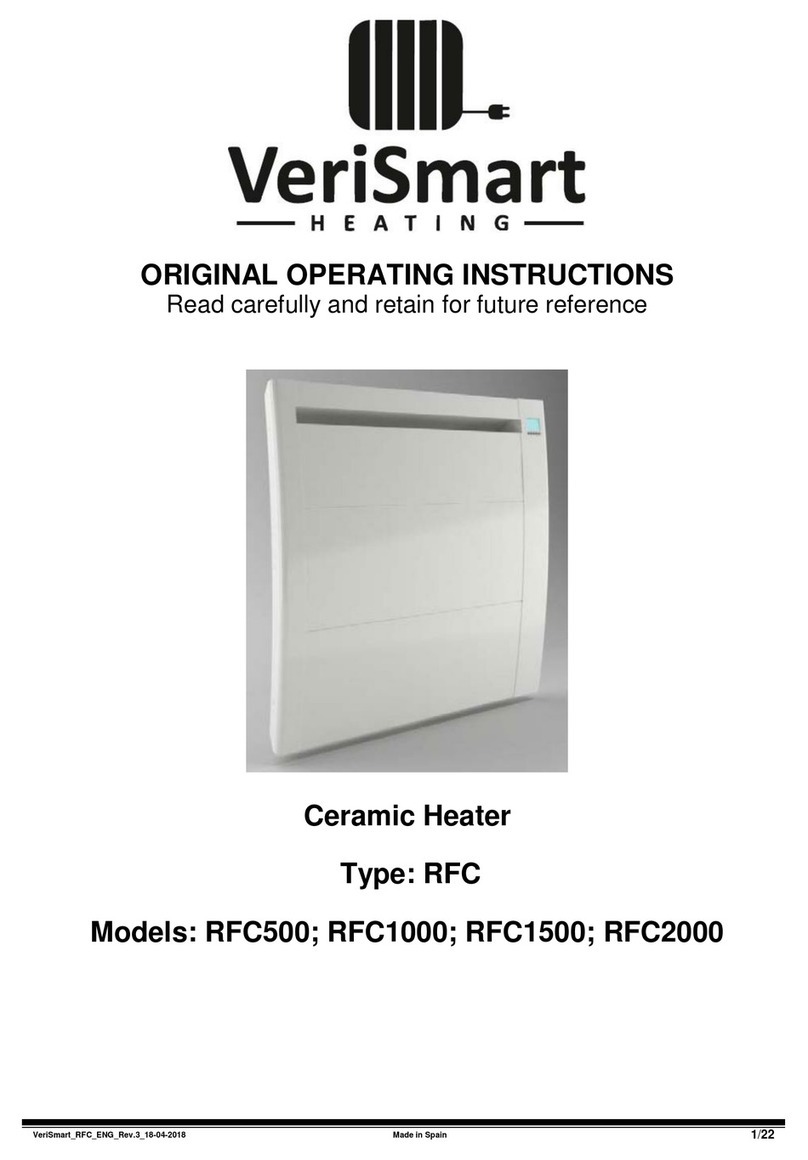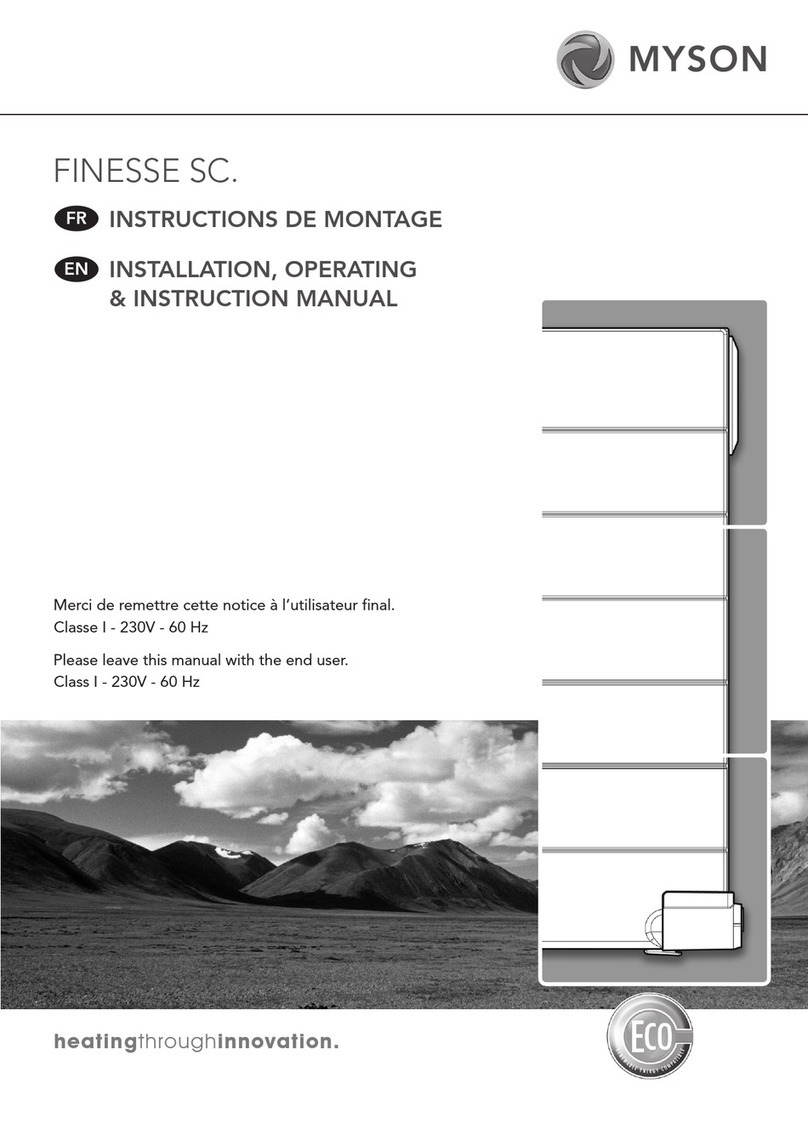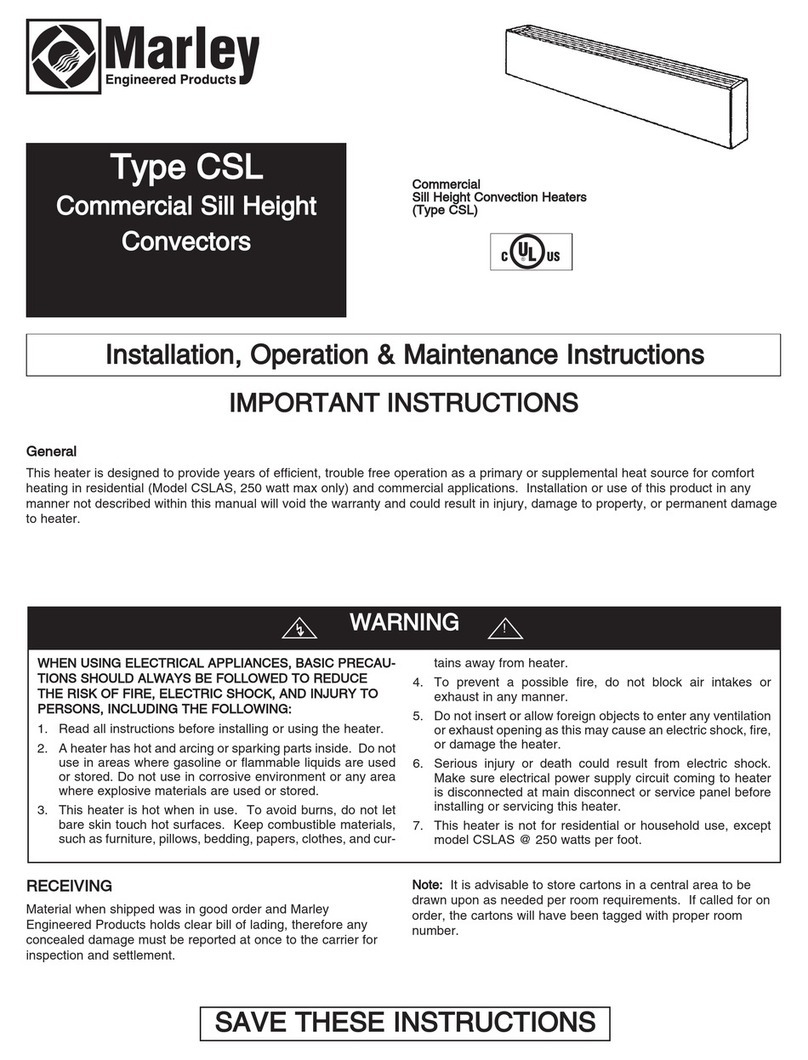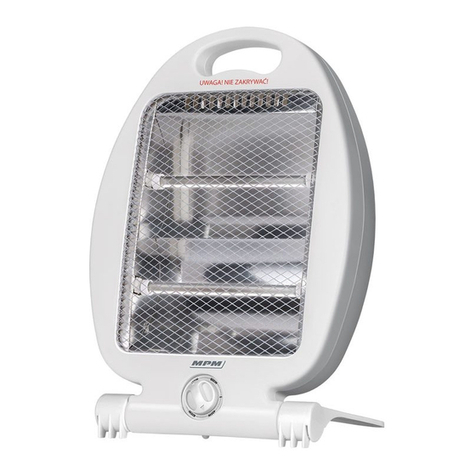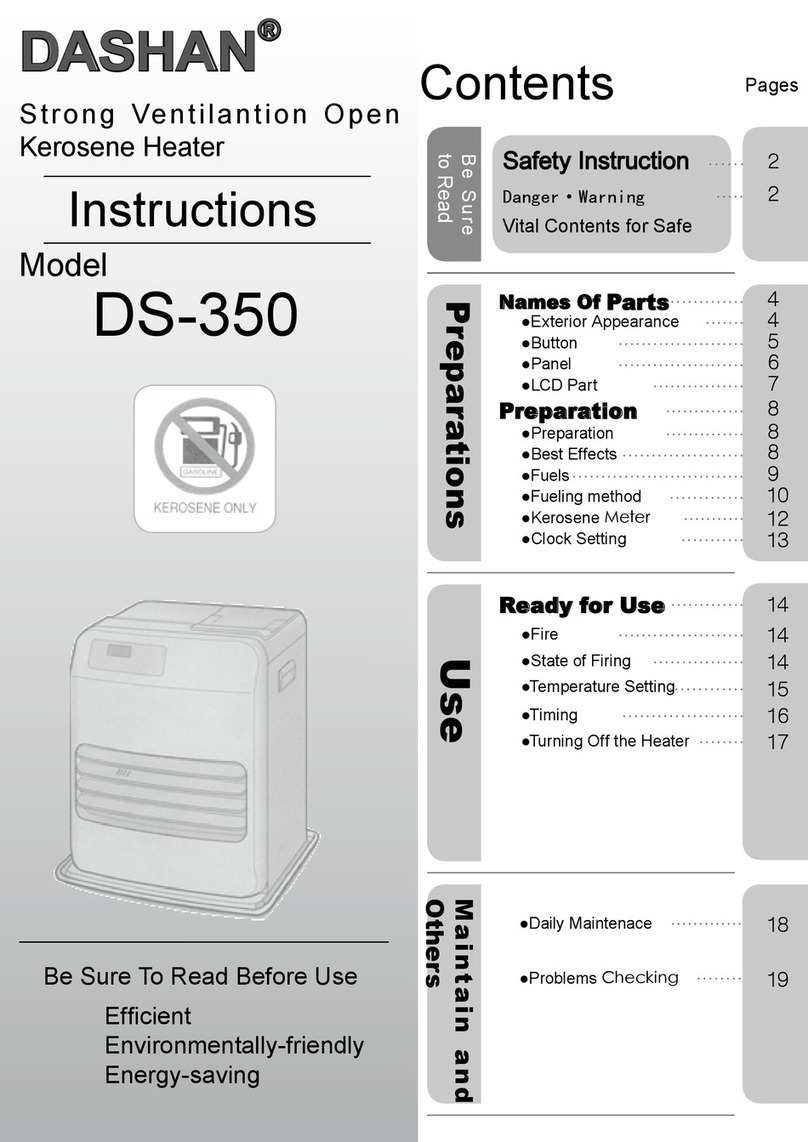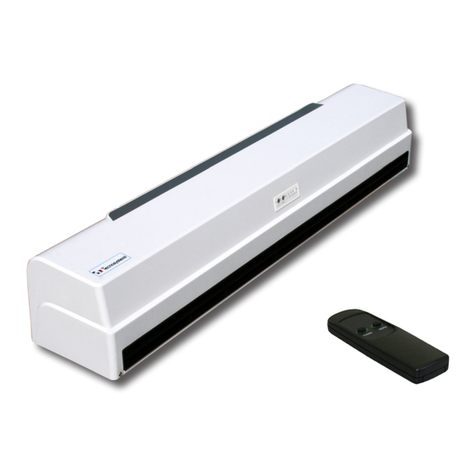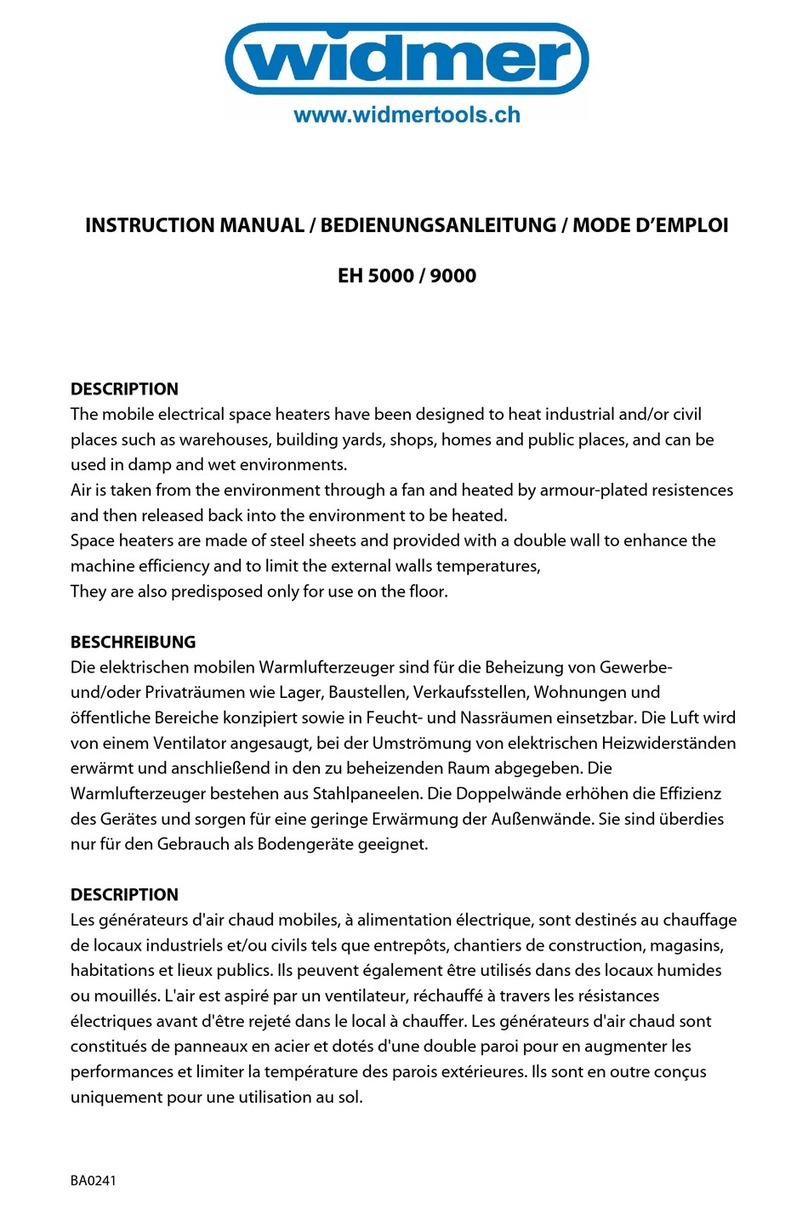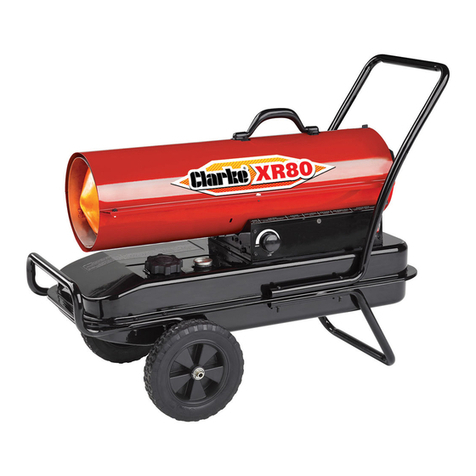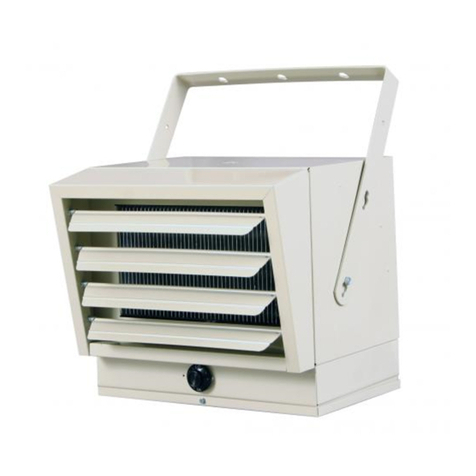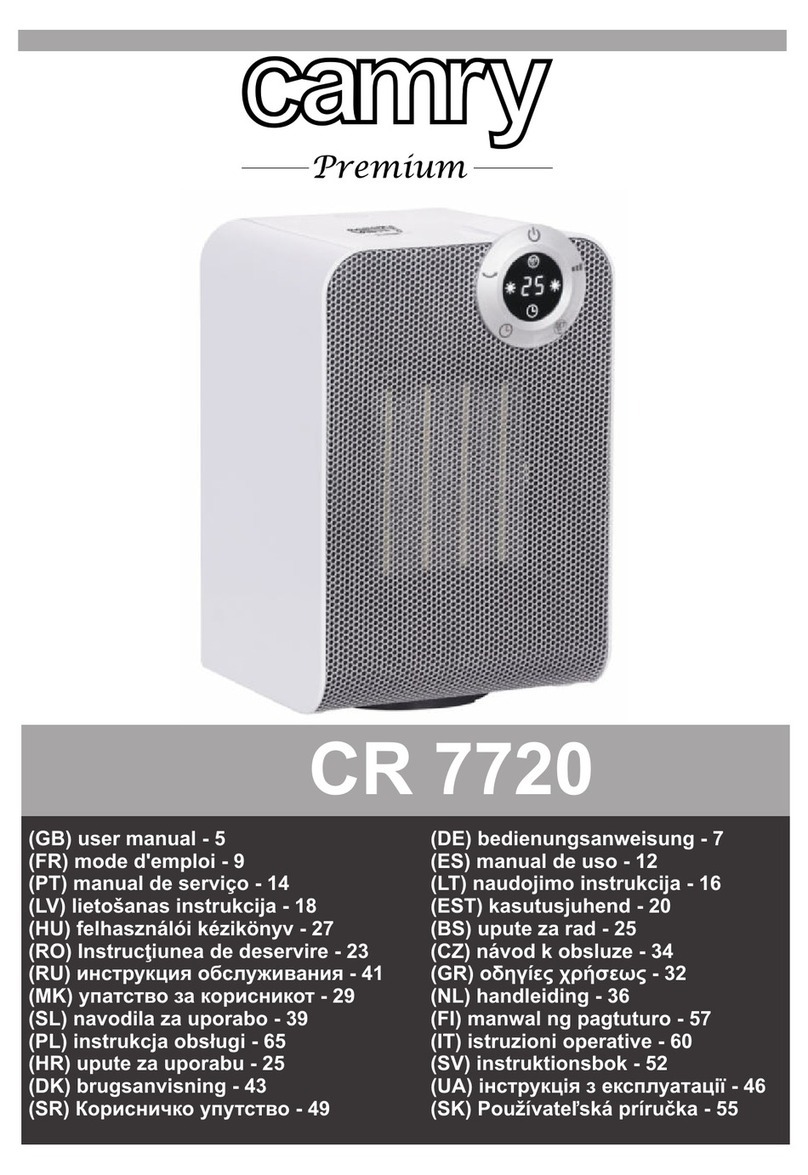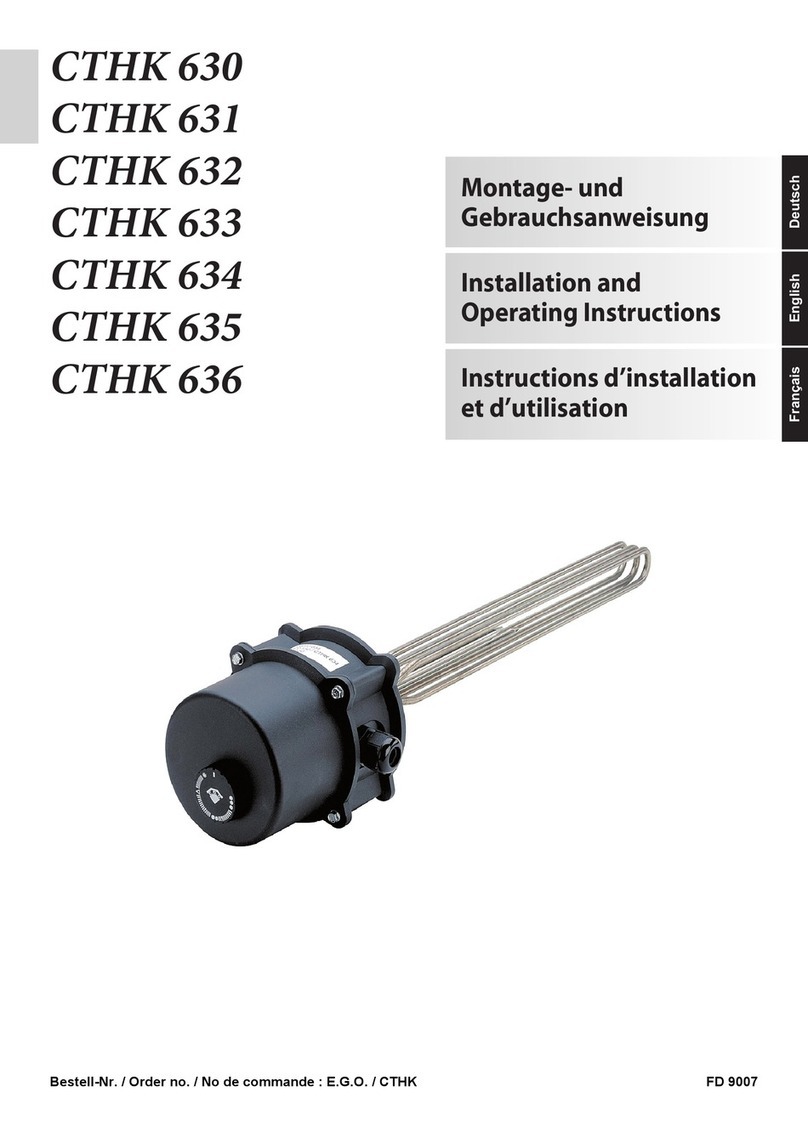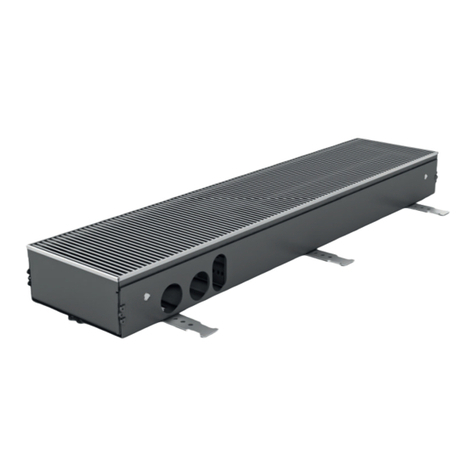Kroll W 401 K manual

881006
046884
W 401 K
Stand 06/2010
Universal- Ölheizer
mit Warmluftgebläse
Betriebs-
anleitung
Chauffage polycombu-
stible avec ventilation
Notice
d’instruction
Multi-Oilheater
with Blower
Instruction
handbook

2
Betriebsanleitung vor Aufstellung und
Inbetriebnahme sorgfältig lesen.
Alle in der Betriebsanleitung beschrie-
benen Einzelheiten bezüglich der
Aufstellung und Inbetriebnahme müssen
sorgfältig durchgeführt und beachtet
werden um einen störungsfreien und
energiesparenden Betrieb zu gewähr-
leisten.
Ausgabe : 881007
Zeichnungs-Nr. 046884
Technische Änderungen im Sinne der
Produktverbesserung vorbehalten.
Vertrieb:
Firma Kroll GmbH
Read the operation instruc-tions careful-
ly, prior to instal-ling and comissioning
the heater.
All details stated, refering tue installa-
tion and setting into operation must be
effected and observed carefully in order
to grant an economic operation free of
malfuctions.
Edition: 881007
Drawing number: 046884
Technical changes in the sense of pro-
duct improvement reserved
Distribution:
Firma Kroll GmbH
Livre attentivement les instructions de
service avant le montage et la mise en
route.
Tous détails mentonnés concernant
l’instal-lation et la mise en route doivent
être et observés seignieusement pour
assurer le fonctionnement éconique et
sans pannes.
Toute modification réservée dans le but
d’amélioration du produit
Edition 881007
No. du dessin: 046884
Toute modification réservée dans le but
de l’amélioration du produit
Service de vente:
Sté Kroll GmbH
Inhaltsverzeichnis 2 Contents 2 Sommaire 2
Einleitung 3 Introduction 3 Introduction 3
Gebläse V470 4 Fan V470 4 Ventilateur V470 4
Inbetriebnahme und
Bedienung 5Proper operating
procedure 5Mise en service et
Utilisation 5
Reinigung
Störung 6Cleaning
Malfunctioning 6Nettoyage
Incidents 6
Abgasrohrführung 7 Stovepipe 7 Le cheminée 7
Einzelteile 8 Component parts 8 Nomenclature 8
Schaltplan 11 Circuit diagram 11 Schema électrique 11
Wartungsintervalle 12 Maintenance table 12 Tableau d’entretien 12
EG-Konformitätserklärung 13 EG-Declaration of conformity 13 EG-Déclaration de conformité 13
Transportschäden 14 Damage during transport 14 Dommages au cours du
transport 14
Wartungsintervalle 15 Servicing intervals 15 Intervalles de maintenance 15

Stand 062010
3
Einleitung
Sie haben sich einen Kroll-Universalöl-Heizer
zugelegt, der Ihnen einwandfreie Funktion,
Sicherheit und einen störungsfreien Einsatz
garantiert, wenn Sie die Aufstellung, Inbe-
triebnahme und Reinigung nach folgenden
Angaben ausführen werden.
Für die Aufstellung gelten die allgemeinen
Vorschriften für Ölheizer der jeweiligen ober-
sten Baubehörde für Ihr Land. Der Ofen darf
keinesfalls in der Nähe brennbarer Flüssigkei-
ten betrieben werden.
Aufstellung
Folgende Teile sind aus dem Heizer zu
nehmen:
Brennschale (18), Pilotring (17), Umlenkklap-
pe (21), Tank (35)
Im Tank befinden sich Ölleitungsrohrbogen
(32), Fiberdichtung (31) für Anschluss zwi-
schen Übergangsstück (59) und Ölleitungs-
rohrbogen und das Sieb (38).
Stellen Sie den Heizer in die Ölauffangwanne
(33). Brennschale (18) mittels des mitgeliefer-
ten Hakens auf den Boden des Brenntopfes
stellen und die Aussparung gegenüber des
Einlaufrohres (30) verdrehen. Pilotring (17)
mit Wölbung nach oben auf den eingeprägten
Rand des Brennertopfes legen. Umlenkklap-
pe (21) in den Winkel über dem Rohrstutzen
einhängen. Den Tank (35) in die Schlitze der
Blende (34) einhängen.
Ölleitungsrohrbogen (32) unten mit Einlauf-
rohr (30) und oben am Tank mit Dichtung
verschrauben. Beim Festschrauben muss
das Übergangsstück (59) an der Pumpe (60)
gegengehalten werden, da sonst die Flucht
der Pumpenachse verändert werden kann.
Die Dichtung ist an dieser Betriebsanleitung
angeheftet.
Den 5-poligen Stecker (64) von links in die
Steckbuchse der Motorkonsole (51) einstek-
ken. Jetzt prüfen Sie, ob der Wasserablass-
hahn am Tank geschlossen und der Alu-Be-
cher (42) lose im Mikroschalterhalter stehen.
Der Mikroschalterhebel muss den Alu-Becher
Introduction
Your new Kroll-Multi-oilheater is guaranteed to
function properly, safely and continously if you
install, operate and clean it in compliance with
the following instructions.
Your installation should comply with oilheater
installation regulations as issued by your local
and national building authorities. The stove
should never be operated near inflammable
liquids.
Installation
Remove following parts from the heater:
burner basin (18), pilot ring (17), baffle (21),
tank (35)
In the tank you will find the oil feed line (32),
the fibre seal (31) for the connection between
the adapter (57) and oil feed line, as well as
the filter (38).
Place the heater on the drip pan (33). Place
the burner basin (18) at the bottom of the oil
chamber using the hook supplied for this pur-
pose and rotate the basin so that the recess
is in the opposite of the inlet pipe (30) Lay
pilot ring (17) on the patterned rim of the oil
chamber. Insert baffle (21) onto bracket above
the flue connection. Hang the tank (35) into
the slits in the housing (34).
Fasten lower end of feed line (32) to inlet line
(30) and the upper end to the tank using the
seal. When screwing on, counterhold reducer
(59) on pump (60) since otherwise alignment
of pump axis may be changed. The seal in a
plastic bag is affixed at the manual.
Insert a 5-terminal plug (64) into the socket at
the left of the motor mount (51).
Now make sure the water drainage cock at
tank is closed and the aluminium catchment
(42) is sitting loosely in the micro-switch hol-
der. The micro-switch lever should press the
aluminium cup upwards.
Introduction
Vous venez de faire l’achat d’un poêle Kroll
pour chauffeur poly combustible. Le fonc-
tionnement impeccable de ce poêle, sa sé-
curité et un service sans incidents vous sont
garanties si vous procédez à l’installation, à la
mise en service et au nettoyage en respectant
les indications suivantes.
L‘installation doit correspondre aux directives
locales. Le pôele ne doit jamais fonctionner
près des liquides inflammables.
Installation
Sortir du chauffeur les pièces suivantes:
la coupelle de combustion (18), le stator
d’évaporation (17), la chicane (21), le réser-
voir (35)
Dans le réservoir se trouvant le tuyau de
liaison (32), un joint en fibre (31) pour le bran-
chement entre le raccord (57) et le tuyau de
liaison supérieur ainsi que le tamis (38).
Poser le chauffeur dans le bac-collecteur
(33). Avec le crochet fourni, poser la coupel-
le de combustion (18) sur le fond du pot de
combustion et amener la découpe en face de
la canne d’alimentation (30). Poser le stator
d’évaporation (17) sur le bord profilé du pot
de combustion. Accrocher la chicane (21)
dans l’angle au-dessus du tuyau. Accrocher
le réservoir (35) dans les fentes de l’écran
thermique (34).
Visser le tuyau de liaison (32) en bas sur la
canne d’alimentation (30) et en haut sur le
réservoir, avec un joint d’étanchéité. Au ser-
rage, il faut retenir le raccord réducteur (59)
monté sur la pompe (60) sinon l’aglimnement
de l’axe de la pompe risque d’être modifié. Ce
joint est agrafé à la presente notice.
Brancher la fiche à 5 broches (64) dans la pri-
se du support du moteur (51), du côté gauche.
Vérifier alors si le robinet du purge est fermé
et si le godet en alu (42) est posé librement
dans le support du microrupteur. Le levier du
microrupteur doit repousser le godet en alu.
vers le haut.
Einleitung / Introduction / Introduction

4
Heizer nur im kalten
Zustand zünden !
Sollte sich nach monatelangem Betrieb in Tank,
Pumpe oder Leitungen Ölschlamm abgesetzt
haben, so nehmen Sie zur Reinigung den Tank
ab. Hierzu Netzstecker, sowie den 5-poligen
Stecker (64) ausstecken und Ölleitungsrohrbo-
gen und das Übergangsstück abschrauben und
die Schlacke ausbohren. Hierzu empfehlen wir
die im Prospekt beschriebenen Reinigungsbür-
ste. Bei zu starker Verschmutzung des Bren-
nertopfes (19) können Sie diesen nach oben
herausnehmen. Hierzu sind Einlaufrohr und die
3 Befestigungsschrauben auf der Zwischenplat-
te auszuschrauben.
Beim Wiedereinbau ist auf dichtes Aufliegen
des Brennertopfrandes auf der Zwischenplatte,
festen Sitz des Einlaufrohres (bei Einlage der
Spezialdichtung) sowie Auslaufrichtung des
Überlaufrohres zum Alu-Becher zu achten. Soll-
te einmal zuviel Wasser im Tank sein, was sich
durch ungleichmäßiges Brennen und starkes
Zischen der Flamme bemerkbar macht, muß
es durch den Wasserablaßhahn abgelassen
werden. Wenn Öl verschüttet wird, ist die
Auffangwanne unbedingt sofort zu reinigen,
sonst besteht Brandgefahr.
Warmluftgebläse V 470
Mit diesem laufruhigen und leistungsstarken
Gebläse wird eine noch schnellere Aufheizung
des Raumes erreicht.
Wird der Heizer ohne Gebläse betrieben wird,
ist der Gebläsedeckel unbedingt zu öffnen !
Bei Überhitzungsschäden besteht kein Ga-
rantieanspruch !
Achtung !
Bei Betrieb mit Gebläse V 470 weder Stecker
vom Gebläse noch Netzstecker ziehen, bevor
das Gerät vollständig abgekühlt ist.
Ignite Heater only
when it is Cold !
If after several months of operation oil sludge
has collected in the tank, pump or in lines
remove the tank for cleaning. First disconnect
the wall plug and the 5-terminal plug (64) and
disconnect the oil feed line from the tank. If the
inlet pipe is clogged, disconnect the feed line
an the adapter and ream out the sludge. We
suggest using a cleaning brush as described in
the prospectus.
If the oil chamber (19) has become too dirty
it can be removed vertically. To do this, first
remove vertically. To do this first remove the
inlet pipe and the three screws on the middle
section.
When reinserting the chamber make sure that
the rim is resting tightly against the middle
section. The intake pipe (with special seal) must
be firmly mounted and the overflow pipe must
be properly located over the catchment.
Uneven burning and a loud hissing sound are a
sign that there is probably too much water in the
tank. It should be drained off through a cock.
The drip pan must be cleaned immediately if
oil is spilled, otherwise there is a fire hazard.
V 470 blower
This quiet-running, high-performance fan unit
helps to heat up the room even faster.
While running the heater without the fan, the
fan cover must always be kept on !
Damage due to overheating is not covered
by the guarantee !
Attention !
When operating with the V 470 fan, do not
disconnect the power supply, to the heater, until
the appliance has entirely cooled down !
Allumer le chauffer
uniquement à froid !
Si, après plusiers mois de service, des boues
d’huile se sont déposés dans le réservoir, la
pompe ou les conduites, démonter le réser-
voir pour le nettoyer. A cet effet, débrancher
la fiche du secteur ainsi que la fiche à 5
broches (64) et dévisser le tuyau de liaison
du réservoir. Si la canne d’alimentation
est obstruée, dévisser le tuyau de liaison
et le raccord puis éliminer les scories à la
perceuse. Pour cela, nous recommandons
l’utilisation de la brosse de nettoyage décrite
dans le prospectus.
Si le pot de combustion (19) est trop forte-
ment encrassé on peut le sortir par le haut.
Pour cela, dévisser la canne d’alimentation
et les trois vis de fixation de la plque de
séparation.
A la repose, veiller à ce que bord du pot de
combustion porte sur la plaque de séparation
en assurant l’étanchéit´requise. S’assurer
que le canne d’alimentation soit bien fixée
(montage du joint spécial) et que le tuyau de
trop-plein débouche dans le godet en alu.
Si le réservoir contient trop d’eau, ce qui se
manifeste par une combustion irrégulière
et un fort crépitement de la flamme, il faut
évacuer l’eau avec le robinet de purge.
Si de l‘huile à été renversée, nettoyer le
bac-collecteur toujours immediament,
après, sinon : risques d‘incendie.
Ventilateur V 470
Ce ventilateur puissant au fonctionnement
silencieux permet un réchauffement encore
plus rapide des locaux.
Si le poêle est utilisé sans ventilateur, il faut
obligatoirement ouvrir le capot du venti-
lateur !
Tout droit à la garantie est exclu pour des
avaries dues à une surchauffe !
Attention !
En ca fonctionnement avec ventilation V
470 tirez ni la prise d’alimentation avant que
l’appareil ne soit pas complétement
refroid !
Gebläse V470 / Fan V470 / Ventilateur V 470

Stand 062010
5
Inbetriebnahme und Bedienung
1. Netzstecker (230V~/50Hz) einstecken
2. Heizöl in den Tank einfüllen
3. Deckel (15) abnehmen und ¼ l Heizöl
in die Brennschale durch die mittlere Öff-
nung des Pilotringes einfüllen
4. Den Wippschalter (55) auf „ein“ stellen
5. Hebel an der Motorkonsole auf Stellung
„niedrige Drehzahl“ (Abb. 1 / Example 1 /
Fig. 1) einrasten (notfalls an der Kupplungs
scheibe drehen, bis das Zahnrad frei wird)
6. Regluierknopf (36) auf Stellung „schwach“
drehen (Abb. 2 / Example 2 / Fig. 2)
7. Das Heizöl in der Brennschale (19) mit
einem Wachsdocht oder in Heizöl getränkter
Putzwolle entzünden
8. Deckel (15) wieder auflegen
Achtung:
Nicht mehr als 1/4 Liter Heizöl einfüllen -
wegen Überhitzungsgefahr.
Den Heizer nur in kaltem Zustand zünden!
Hat der Heizer die nötige Betriebstemperatur
erreicht (je nach Raumtemperatur 10 - 15 Min.)
schaltet der Thermostat (44) den Getriebemotor
(56) mit Zahnradpumpe (60) ein und die gelbe
Signalleuchte (54) leuchtet.
Lassen Sie den Heizer die ersten 20 MIn. auf
Stellung „niedrige Drehzahl“ am Hebel der
Motorkonsole laufen. Falls erforderlich, können
Sie danach den Regulierknopf (36) auf „stark“
stellen.
Bei Verwendung von Heizöl EL nur auf
Stellung „niedrige Drehzahl“ betreiben.
Nachregulieren mittels Regulierknopf .
Abstellen
Den Wippschalter auf Stellung „aus“ und den
Abstellhahn zudrehen.
Commissioning and operation
1. Plug in the mains plug (230V~/50Hz)
2. Fill heating oil into the tank
3. Take off the cover (15) and fill about ¼ litre
heating oil into the burner basin via the
central opening of the pilot ring
4. Put the rocker switch (55) to “ein”
5. Put the adjusting lever at the motor console
to “lower speed”, it will fix itself (if neces
sary, turn the coupling disk until the cog
wheel gets free)
6. Put the adjustment knob (36) into position
“weak”
7. Ignite the heating oil in the burner basin
(19) with a wax packing or with in heating oil
impregnated cleaning wooll
8. Put on the cover (15) again
Attention:
Do not fill in more than ¼ litre of heating oil
due to danger of overheating.
Only ignite the heater while it is cold !
When the heater has reached the necessary
operating temperature (depending on the room
temperature, this can take 10 – 15 minutes),
the thermostat (44) turns on the gear motor (56)
with the gear pump (60) and the yellow signal
lamp (54) is glowing.
For the first 20 minutes, let the heater run on
“low speed” at the adjusting lever of the motor
console. If necessary, you can then adjust the
adjustment knob (36) to “strong”.
If you use heating oil EL, only run the
heater at “low speed”. Adjustment via
adjustement knob.
Turning off
Put the adjusting lever to “off” and close the
stop cock.
Mise en service et utilisation
1. Brancher la fiche sur le secteur (230V~/50Hz)
2. Verser de l’huile dans le reservoir
3. Enlever le couvercle (15) et verser ¼ l de
l’huile dans la coupelle par l’ouverture au
mileu du stator.
4. Mettre l’interrupteur en position «ein» (=
marche)
5. Ajuster le levier de régulation (55) sur
«faible vitesse» ( fig.1). Si nécessaire, tour
ner le disque d’accouplement jusqu’à ce que
la roue d’engrenage soit libérée.
6. Tourner le bouton de régulation (36) sur
position «schwach» = faible (fig.2)
7. Allumer le feu avec une mèche de cire ou
avec la bourre de laine imbibée de mazout
dans la coupelle (19).
8. Remettre le couvercle (15)
Attention :
Ne pas verser plus de 1/4l de mazout, sinon :
risques de surchauffe !
Allumer le chauffage uniquement à froid !
Une foi, le chauffage a atteint la température de
service nécessaire (au bout de 10 à 15 minutes,
suivant la température ambiante), le thermostat
(44) met en march le moteur-réducteur (56) avec
pompe à engrenages (60) et la lampe temoin
jaune (54) s’allume. Laisser le chauffage fonc-
tionner sur feu „faible“ au levier de régulation
à la console moteur pendant les 20 premières
minutes. Si nécessaire, amener le bouton de
régulation (36) sur „stark“ = fort.
En cas d’utilisation du fioul doméstique
EL, faire fonctionner le poêle
seulement en position „schwach“ =
faible. Procéder à la régulation avec le
bouton de régulation.
Arrêt
Mettre l’interrupteur en position „aus“ = arrêt et
fermer le robinet principal.
Inbetriebnahme und Bedienung / Proper operation procedure
Mise en service et utilisation
Abb. 2 / Example 2 / Fig. 2
Abb. 1 / Example 1 / Fig. 1

6
Reinigung / Cleaning / Nettoyage
Störung / Malfunctioning / Incidents
Nettoyage
Lors de la combustion d’huiles de récupération,
des socories et autres résidus de combustion
sont inévitables. Notre coupelle dombustion (18)
représente une solution éprouvée pour le net-
toyage. Avec le crochet fourni, sortir tout d’abord
le stator d’evaporation (17) plus faire tourner la
coupelle de combustion pour amener la découpe
du côté de la canne d’alimentation (30) plus
la sortir par le haut, à l’horizontale. L’appareil
doit être nettoyé quodiennement. Dans ce cas,
les scories s’enlévent facilement en quelques
minutes. Les scories s’enlèvent facilement en
quelques minutes. Les scories ne doivent jamais
dépasser le bord de la coupelle de combustion.
Il est avantageux de faire l’acquisition d’une deu-
xième coupelle de remplacement et de pulvérser
le Décap-cendres Kroll (Numéro de comande-
Nr. 000721) sur la coupelle de combustion et sur
le pot de combustion .
Incidents
Se le chauffer s’éteint pour une raison quelcon-
que, sans qu’on s’en apercoive, le thermostat
arrête la pompe lorsque la température tombe.
Si l’on utilise de l’huile brûlant mal ou que la cou-
pelle de combustion contient trop de scories et
que le niveau d’huile monte excessivement dans
le pot de combustion, l’huile parvient dans le
godet en alu (42) à travers le tuyau de trop-plein
(41). Sous l’effet de l’augmentation du poids du
godet, le microrrupteur arête le moteur de la
pompe. Si la coupelle de combustion renferme
plus de 1/4 de litre d’huile, il faut vider la quantité
excédentaire avant de rallumer le feu. Eliminer
préalablement l’origine de cette perturbation et
vider le godet en alu.
Reinigung
Schlackenrückstände sind bei der Altölverbren-
nung unvermeidlich. Zur leichten Reinigung
hilft unsere bewährte Brennschale (18). Mit
dem mitgelieferten Haken nehmen Sie zuerst
den Pilotring (17) heraus, dann drehen Sie die
Brennschale (18) mit der Aussparung zum Ein-
laufrohr (30) und nehmen Sie waagrecht nach
oben heraus. Das Gerät muss täglich gereinigt
werden. Dadurch wird eine leichte Schlacken-
entfernung gewährleistet, welche nur wenige
Minuten in Anspruch nimmt. Die Schlacke darf
keinesfalls über den Rand der Brennschale
kommen. Sehr vorteilhaft ist die Anschaffung
einer zweiten Brennschale zum Auswechseln
und das Einsprühen der Brennschale und des
Brennertopfes (19) mit Kroll-Schlackenlöser
(Bestell-Nr. 000721)
Prüfen Sie von Zeit zu Zeit das Öl-Einlaufrohr,
da dies mit Kohle verstopft sein kann.
Um die Verstopfung zu beseitigen führen Sie
einen Bohrer Ø 13mm hindurch um die Verstop-
fung zu beseitigen und benützen Sie den Kroll
Schlackenlöser (Artikel-Nr. 00721)
Störung
Wenn der Heizer einmal unbemerkt durch
irgendwelche Umstände ausgeht, schaltet das
Thermostat bei absinkender Temperatur die
Pumpe ab. Sollte bei Verwendung von schlecht
brennbarem Öl oder durch zuviel Schlacke in
der Brennschale der Ölspiegel im Brennertopf
zu hoch steigen, so läuft das Öl in den Alu-
Becher (42) der Überlaufsicherung (41). Dieser
schaltet durch das zunehmende Gewicht über
den Mikroschalter den Pumpenmotor ab. Sollte
sich mehr als 1/4 Liter Öl in der Brennschale
befinden, muss dieses vor erneutem Anzünden
entfernt werden. Zuvor die Ursache beheben
und den Alu-Becher entleeren.
Cleaning
Burning waste oil unavoidably leads to slag
residues. Our burner basin (18) has proved very
effective for cleaning operations. First remove
the pilot ring (17) using the hook accessory,
then rotate the burner basin (18) recess around
to the inlet pipe (30) and lift the basin out
while keeping it horizontal. The stove must be
cleaned daily. The quantity of slag residue to be
removed is then small and the operation takes
only a few minutes. The residue should never
be allowed to spill over the rim of the basin. A
good system is to keep a second basin with
which to replace the dirty on every second day
and to spray Kroll Slag Solvent (Requisition-Nr.
000721) onto the basin and into the oil chamber
(19).
Periodically inspect the oil inlet pipe, as this
may block up with carbon. Run a 13mm drill bit
through it, to remove any carbon present.
(Requisition-Nr. 000721)
Malfunctioning
If the heater should go out unnoticed for any
reason, the thermostat switches off the pump
when the temperature has fallen to a certain
level. If too much oil collects in the oil chamber
because it is burning poorly or there is too much
slag in the basin, the excess oil will run through
the overflow pipe (42) into the catchment (41). A
certain weight of overflow oil causes the micros-
witch to shut off the pump motor. If more than
1/4 pint of oil is in the basin it must be removed
before reigniting the stove. Determine the cau-
se of malfunctioning and empty the catchment
before reigniting.

Stand 062010
7
Abgasrohrführung
Der Heizer muss an einen Schornstein oder
Abgasleitung angeschlossen werden, dessen
Mündung das Dach mind. um 1m bzw. den
Gebäudefirst mind. um 0,5m überragt.
Abgasschornsteine müssen im freien Wind-
strom liegen. Die Mündung des Abgasrohres
darf nicht in unmittelbarer Nähe von Fenstern
und Balkonen liegen.
Beim Verlegen der Abgasrohre ist auf fort-
währende Steigung (Abb.“a“) und richtiges
zusammenstecken in Zugrichtung zu achten.
Der Rohrdurchmesser (Abb.“b“) muss wegen
guter Zugführung größer als der Stutzen-
durchmesser sein. Waagerecht verlegte
Abgasrohre (Abb. „c“) dürfen nicht länger als
1/3 der gesamten Abgasrohrlänge betragen.
Am Fuße des Rauchgasabzuges sammeln
sich Kondens- und Regenwasser. Deshalb
muss möglichst weit unten (Abb. „d“) am Ab-
gasrohr ein Kapselwinkel eingebaut werden.
Für eine saubere Verbrennung ist genü-
gend Zug erforderlich.
Bei W401K 0,25 - 0,4 mbar. Die wirksame
Schornsteinhöhe muss mind. 4m betragen.
Stovepipe
The heater must be connected to a chimney
or other flue pipe whose head is at least 0,5m
above the roof ridge or else 1m above other
roof locations.
Flue outlets must stand in direct wind cur-
rents. The flue head may not be located in the
immediate vincinity of windows or balconies.
In laying the flue pipes it is important to
maintain upward slope (example “a“) and
insert pipe sections properly in the direction of
exhaust.
The pipe diameter (example “b“) must be
larger than the diameter of the stove connec-
tion to ensure proper drawing. Horizontal pipe
sections (example “c“) may not be longer than
one third of the total flue length.
Rain and condensation water collect at the
bottom of the flue. It is therefore important to
install a cap elbow as low as possible (examp-
le “d“) in the flue pipe.
The flue must draw properly to ensure
adequate, smokeless combustion.
This is 0,25 - 0,4 mbar for the W 401K . The
flue height must be at least 4m to be effective.
Le cheminée
Le chauffer doit ête raccordé à une cheminée
ou à conduite de fumée au moins à 1m au-
dessus du toit ou au moins à 0,5m au-dessus
du faite du bâtiment.
La cheminée doit se trouver dans une zone de
libre circulation vent. Elle ne doit pas débou-
cher à proximité immédiate de fenêtres et de
balcons.
Lors de l’installation des tuyaux de poêle, is faut
veiller à ce que ceux-ci soient toujours dirigés
vers le haut (fig. „a“) et correctement emboîtés
dans le sens du tirage.
Pour garantir un bon tirage, il faut que le
diamètre du tuyau (fig. „b“) soit supérieur au
diamètre du raccord. La Longueur de tuyaux
de poêle posés à l’horizontale (fig. „c“) ne doit
dépasser 1/3 de la longueur totale des tuyaux
de poêle.
Au point le plus bas de la cheminée
s’accumulen l’eau de pluie et la condesation.
C’est pouquoi il faut monter un te tampon sur le
tuyau de poêle, le plus bas possible (fig. „d“)
Pour une combustion propre, un bon tirage
est néccessaire.
C’est-à-dire: 0,25 - 0,4 mbar pour W401. La
hauteur utile de la cheminée doit atteindre au
moins 4mm.
Abgasrohrführung / Stovepipe / Le cheminée
Einleitung / Introduction / Introduction

8
Einzelteile / Component parts / Nomenclature

Stand 062010
9
Einzelteile Component parts Nomenclature Bestell-Nr. /Requisition
number
Numéro de commande
1 Gebläse kpl. Fan complete Ventilateur complète 046887
2 Deckel rechts Cover right Couvercle à droite 001465
3 Deckel links Cover left Couvercle à gauche 001466
4 Querstromgebläse kpl. Fan complete Ventilateur complète 005319
5 Lageraufnahme Bearing stocktaking support roulement 005524
6 Kugellager Ballbearing roulement a bille 005338
7 Lüfterwalze Turbine Turbine 005384
8 Kondensator 2μF Capacitor 2μF Condensateur 005385
9 O-Ring Seal joint torique 005523
10 Kupplung (8mm Welle ) Coupling(8mm) Accomplement 8mm 005315
11 Motor Motor Moteur 005382
12 Druckfeder Compression spring Ressort 005381
13 Klemmleiste Connecting strip Barre a borne 022255
14 Silikonleitung (Kabel) Cable Cable 006451-01
15 Deckel Cover Couvercle 001856
16 Abdeckplatte Cover plate Couronne de couvercle 001823
17 Pilotring Pilot ring Stator d’évoporation 011641
18 Brennschale Burner basin Coupelle de combustion 011639
19 Brennertopf Oil chamber Pot de combustion 001455
20 Abdeckblech zu Brennertopf Cover plate for oil chamber Tôle de protection
pour pot de combustion 001824
21 Umlenkklappe Baffle Chicane 001822
22 Brennkammer kpl. Combustion chamber cpl. Chambre de combustion complète 001457
23 Lochblech rechts Perforated plate right Tôle perforé à droite 001810
24 Lochblech vorne Perforated plate left Tôle perforé à l‘avant 001812
25 Kabelkanal Cable channel Canal pour câble 047208
26 Lochblech links Perforated plate left Tôle perforé à gauche 001811-01
27 Gebläseisolierung Fan insulating Isolement de soufflerie 011649
28 Verbrennungsluftgebläse Combustion air fan Soufflerie de combustion 001837
29 IT-Dichtung Seal Joint 005386
30 Einlaufrohr vormontiert Oil inlet pre assembled Canne d’alimentation sous groupe 000720
31 Fiberdichtung Fiber seal Joint en fibres 003339
32 Ölleitungsrohrbogen Oil feed line Tuyau de liaison 000954
33 Auffangwanne Drip pan Bac-collecteur 001813
34 Blende Cover Bandeau 001825
35 Tank komplett montiert Tank complete assembled Réservoir complètement monté 000716-01
36 Regulierknopf Adjusting knob Bouton de réglage 036504
37 Verbindungssgestänge Connecting rod Barre de connexion 000956
38 Tankdeckel Tank cover Bouchon de réservoir 0001827-01
39 Tanksieb Strainer Tamis 001460
40 Tank Tank Réservoir 000950-01
Einzelteile / Component parts / Nomenclature

10
Einzelteile Component parts Nomenclature Bestell-Nr. /Requisition
number
Numéro de commande
41a
Überlaufsicherung kpl. ohne
Gebläse
Overflow protection cpl.
without fan
Protection de débordement cpl.
sans ventilateur 000719
41a Überlaufsicherung kpl. mit
Gebläse
Overflow protection cpl.
with fan
Protection de débordement cpl.
avec ventilateur 000718
42 Alubecher Aluminium catchment Godet en alu 005252
43 Reihenklemmleiste Strip terminal Bornier 006488
44 Thermostat Thermostat Thermostat 005439
45 Mikroschalter Microswitch Microrupteur 025317
46 Zwischenlage Spacer Intercalation 006556
47 Überlaufsicherungshalter kpl. Holder for overflow protection
cpl.
Support pour protection
de débordement cpl. 001461-01
48 Kabelzugentlastung Cable strain relief Décharge de traction 006463
49 Kabelzugentlastung Cable strain relief Décharge de traction 006464
50 Kabel mit Stecker Power cord with plug Câble d’alimentation avec prise 006453
51 Motorkonsole kpl. montiert Motor mount
complete assembled
Support de moteur complete
assembler 000717
52 Kabelzugentlastung Cable strain relief 006464
52a Motordeckel ohne Zeichnung Motor cover without drawing Couvercle moteur sans dessin 001833
53 Motorkonsole kpl. Motor mount cpl. Support de moteur cpl. 000952
54 Signalleuchte gelb Indicator light yellow Lampe de dérangement jaune++ 006502
55 Wippschalter Rocker switch Commutateur 006529
56 Motor Motor Moteur 005351
57 Kupplungsscheibe mit Schlitz Clutch disk slit Disque d’accouplement avec fente 006339
58 Kupplungsscheibe mit Stift Clutch disk with peg Disque d’accouplement avec
goupille 006340
59 Übergangsstück unten Lower adaption portion Raccord inférieur 011647
60 Zahnradpumpe Gear pump Pompe à engenages 005513
61 Übergangsstück oben Upper adaption portion Raccord supérior 011646
62 O-Ring Seal Joint 003370
63 Netzkabel Power cord with plug Cordon électrique 06448
64 Buchsenteil 5-pol. Jack 5-pol. Prise femelle 5-pol. 006404
65 Buchsenteil 3-pol. Jack 3-pol. Prise femelle 3-pol. 006402
66 Reinigungskrücke Cleaning crotchet Crochet pour nettoage 000949
Schlackenlöser Slag solvent Décap-cendres 000721
Einzelteile / Component parts / Nomenclature

Stand 062010
11
B1 Thermostat B1 Thermostat B1 Thermostat
B2 Mikroschalter B2 Micro switch B2 Microrupteur
H1 Signallampe H1 Operating lamp H1 Lampe d’utilisation
M1 Verbrennungsluftgebläse M1 Combustion air fan M1 Soufflerie d’air de combustion
M2 Getriebemotor M2 Motor M2 Moteur
S1 EIN/AUS Schalter S1 ON/OFF switch S1 Interrupteur MARCHE/ARRET
X1 Motorkonsole X1 Motor bracket X1 Bloc complet moteur
X2 Überlaufsicherung X2 Overflow security X2 Sécurité de débordement
X3 Verbrennungsluftgebläse X3 Combustion air fan X3 Soufflerie d’air de combustion
Schaltplan / Circuit diagram / Schema électrique

12
Wartungsintervalle / Maintenance table / Tableau d’entreteien
Intervalle / period / Fréquence
täglich
daily
jounalière
wöchentlich
weekly
Hebdomadaire
Monatlich
Monthly
mensuel
Jährlich
annually
annuel
Reinigen Sie die Brennschale
Clean the burner basin
Nettoyez le coupelle de combustion X
Lassen Sie das Kondenswasser des Kraftstofftanks ab
Drain (water of) condensation from the fuel tank, when
the waste oil contains water
Purgez la condensatio (eau) du reservoir de
combustible si déchét d’huile continent de l’eau
X
Reinigen Sie Brennkammer und Pilotring mit einer
Stahlbürste.
Clean the combustion chamber and the pilot ring with a
steel brush.
Nettoyez la chambre de combustion et le stator
d’évoporation avec une brosse à dents.
X
Reinigen Sie das Überlaufrohr im Boden der
Brennkammer.
Clean the oil overflow pipe in the floor of the
combustion chamber.
Nettoyez le tuyau de trop plein d’huile au fond de la
chambre de combustion
X
Überprüfen Sie die Kraftstoffzufuhrleitung auf undichte
Stellen.
Check the oil pipes for leakage
Vérifiez si les tuyaux d’huile présent une fuite.
X
Reinigen Sie Tank und Tankfilter. Der Tank kann leicht
abgenommen werden.
Clean the fuel tank and the tank filter. The fuel tank can
easily be removed.
Nettoyez le réservoir de combustible et le filtre à
réservoir à combustible.
Le réservoir à combustible est facilement amovible.
X
Überprüfen Sie den Warmluftventilator und reinigen Sie
ihn.
Check the hot air fan and clean if necessary.
Contrôlez le ventilateur d’air chaud et nettoyez-le au
besoin
X
Reinigen Sie das Schornsteinverbindungsrohr.
Clean the chimney connecting pipe.
Nettoyez la vanne de tuyau de cheminée. X
Überprüfen Sie die Anschlüsse des Heizers.
Check the heaters wiring
Vérfier le câblage du générateur X
Wartungsintervalle / Maintenance table / Tableau d‘entretien

Stand 062010
13
EG – Konformitätserklärung
EG – Declaration of conformity
EG – Déclaration de conformité
Der Hersteller
The manufacturer / Le fabricant Kroll GmbH
Pfarrgartenstraße 46, D-71737 Kirchberg
Tel. 07144/830-0
Dokumentationsbevollmächtigter
Authorized person for documentation
Personne authorisée pour la
documentation
Josef Cuntz
erklärt hiermit, dass folgende Produkte / Herewith declares that the following products
Explique par ce document que les produits suivants
Produktbezeichnung
Description / Désignation du produit Universal - Ölheizer
Multi - Oilheater / Chauffer poly combustible
Typenbezeichnung / Type / Type W 401 – L, W 401 – VL, W401 - K
allen einschlägigen Bestimmungen der
folgenden Richtlinien entspricht
correspond to all relevant regulations of
the following guidelines
Correspondent à tous les spécifications
des directives suivantes
2006/42/EG Maschinen
Machines / Machines
2006/95/EG Elektrische Betriebsmittel zur
Verwendung innerhalb bestimmter
Spannungsgrenzen
Electrical devices for use within
certain voltage limits
Matériel électrique pour utilisation
dans certaines limites de voltage
2004/108/EG Elektromagnetische Verträglichkeit
Electromagnetic compatibility
Compatibilité électromagnetique
Kirchberg, 13.07.2010
Alfred Schmid
Geschäftsführer / Director / Directeur

14
Dommages au cours du transport
Les dommages survenus au cours du transport
doivent être notés sur le bon reception et signé
par le conducteur. Des dommages techniques
doivent être signalés sous 48 heures avant
le montage et la mise en service auprès de
votre revendeur. Ne mettre l’appareil en service
qu’après la remise en état.
Par l’inobservation des directives légales,
l’inobservation des directives de cette notice
d’instruction et des schémas électriques dedans,
des pannes et malfonctions pourraient résulter,
ce qui entraine l’expiration du droit de garantie.
Transportschäden
Transportschäden müssen auf dem
Speditionsannahmeschein vermerkt und
vom Fahrer quittiert werden. Technische
Störungen müssen unverzüglich Ihrem
Händler angezeigt werden. Gerät erst
nach Instandsetzung in Betrieb nehmen.
Bei Nichtbeachtung der einschlägigen
Vorschriften, der Nichteinhaltung der
Vorschriften in der Betriebsanleitung und
der elektrischen Schaltpläne können
Funktionsstörungen mit Folgeschäden
entstehen - dadurch erlischt jeglicher Ge-
währleistungsanspruch.
Damage during transport
Transport damages must be noted on
the forwarders receipt and signed by the
driver. Your dealer must be notified of any
technical damage before the appleance
is assembled and set into operation. The
heater is only be started up after compe-
tent repair.
Non-observation of the current regula-
tions, of this manual or of the electrical
wiring diagrams may cause malfunctions
and damages – this leads to loss of any
warranty claim.
Bei nicht bestimmungsgemäßer Verwendung , Aufstellung, Wartung , wie in der Betriebsanleitung vorgegeben oder eigen-
mächtigen Änderungen an der werkseitig gelieferten Geräteausführung erlischt jeglicher
Gewährleistungsanspruch.
Im Übrigen gelten unsere „Verkaufs- und Lieferbedingungen“
Technische Änderungen im Sinne der Produktverbesserung vorbehalten.
Any use, installation, maintenance that is not effected according to the rules as asserted in the technical manual, or unautho-
rized modifications on the original version as delivered from manufacturer leads to expiration of any right to warranty.
Furtheron our „Conditions of Sales and Delivery“ are valid.
Technical modification for product improvement are subject to change without notice.
Toute utilisation, installation et maintenance qui ne soit pas effectué conformément aux directives fixés dans le manuel
technique, ainsi que toute modification à l’appareil livré du fabricant dans sa version originale, entraîne l’expiration du droit de
garantie.
En plus, nos „Conditions de vente et de livraison“ sont en vigueur.
Sous réserve de modification technique dans le sens d’amélioration du produit.

Stand 062010
15
Wartungsintervalle / Servicing intervals / Intervalles de maintenance
Tag der Wartung
Day of servicing
Jour de maintenance
Name
Name
Nom
Bemerkungen
Notes
Notes

Kroll GmbH
Pfarrgartenstraße 46
D-71737 Kirchberg/Murr
Telefon (0049) 07144 / 830 200
Telefax (0049) 07144 / 830 201
e-mail [email protected]
Internet www.kroll.de
Service Hotline (0049) 07144 / 830 222
Kroll UK Ltd.
UK & Ireland Subsidiary
BH 21 6SZ Wimborne-Dorset
Great Britain
Phone (0044) 12 02 82 22 21
Fax (0044) 12 02 82 22 22
e-mail [email protected]
Internet www.krolluk.com
Kroll France
SA au capital de 399 900 € HT
RCS Villefranche / Saône Tarare
B 408 546 943 APE 516 A
TVA N° 57 408 546 943
Telefon (0049) 07144 / 830 149
Telefax (0049) 07144 / 830 201
e-mail [email protected]
Internet www.kroll.de
Table of contents
Other Kroll Heater manuals

